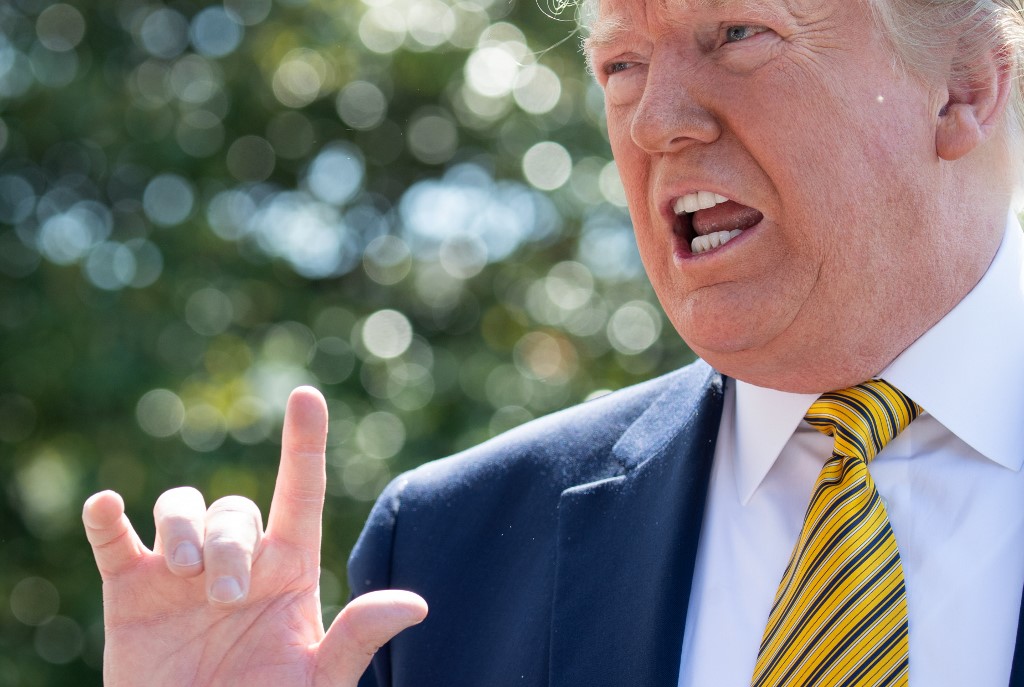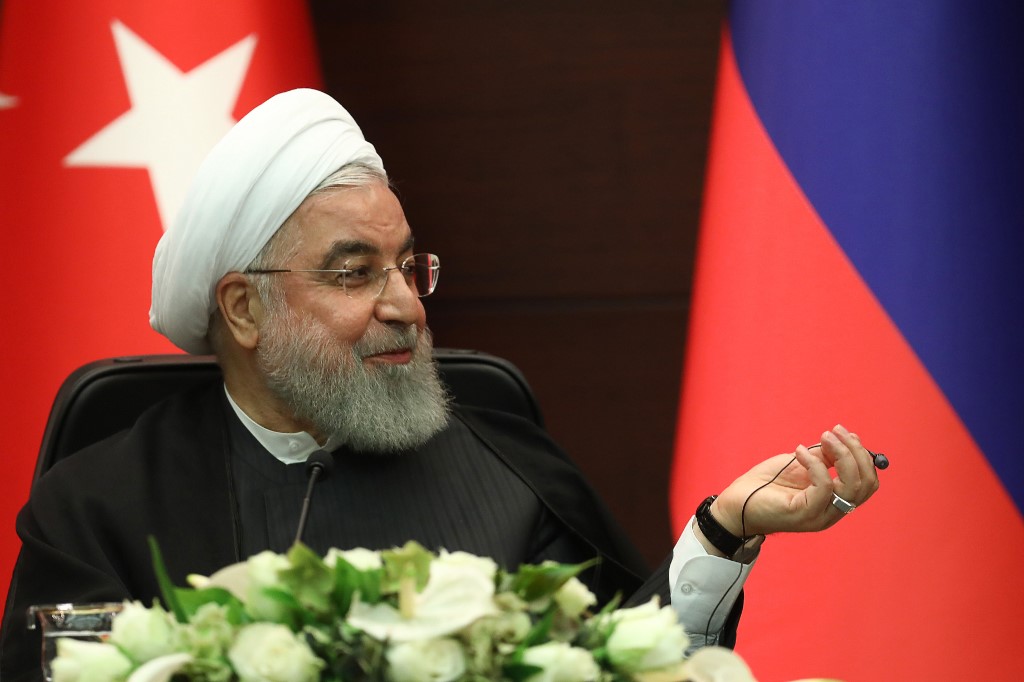As regional tensions rise, Tehran and Washington are inching towards a confrontation that could transform the region
A mural depicts the Iranian national flag in Tehran on 19 September (AFP)
The dramatic attack last Saturday on two major Saudi oil facilities has underscored the supercharged tensions that run across much of the region.
The attacks on the Abqaiq and Khurais oil facilities, run by the state-owned Aramco, have touched off a flurry of speculation about imminent military reprisals.
US officials, notably Secretary of State Mike Pompeo, lost no time in attributing the attacks to Iran. Vice President Mike Pence gave a bullish speech, where in true Trumpian fashion, he claimed the US is “locked and loaded” to defend its interests and those of its allies.
Slow-motion escalation
Yet, while regional tensions have reached a point where several rounds of direct hostilities may be inevitable, a fully fledged war between Iran and the US remains unlikely.
The slow-motion escalation since the summer might be immediately attributable to the Trump administration’s “maximum pressure” campaign against Iran, but its real causes are much deeper. There has been a shift in the regional balance of power, and Iran has reached the point of no return in terms of displacing the US as the dominant regional power.
Iran has reached the point of no return in terms of displacing the US as the dominant regional power
US President Donald Trump’s approach and policies have speeded up this process, creating the conditions for a clash.
While the shape, scale and trajectory of the looming confrontation is difficult to imagine in detail, one thing is certain: Iran holds the advantage at the political, diplomatic, informational and even military domain.
In trying to understand the situation, it is helpful to examine the foundational constructs of Iran-US relations over the past four decades. While it is no secret that Iran and the US have been bitter rivals since the Iranian revolution of 1979, what is less understood is the complex set of implicit protocols that have guided bilateral relations since then.
Despite the intense strategic rivalry in the region, especially in the Gulf arena, Iran and the US have generally avoided military conflict, with one notable exception. Operation Praying Mantis in April 1988, during the closing stages of the Iran-Iraq War, was a fierce one-day naval battle, during which the US destroyed a significant portion of the Iranian navy. The US navy regards the battle as its biggest engagement since the Second World War.
But Praying Mantis was the exception that proved the rule. Since the end of the Iran-Iraq War, there hasn’t been a single military encounter between the two powers, despite repeated provocations by both sides.
Belligerent posturing
This has given rise to an implicit doctrine that can best be described as “no war no peace”, whose foundational concepts have, broadly speaking, served the interests of all key stakeholders.
Iran and the US have both benefited from the standoff, which has allowed both powers to adopt a belligerent posture in the Middle East without coming to blows. This has created space for them to protect their interests and consolidate influence, without touching off serious regional instability.

It has also allowed for rare instances of highly qualified cooperation, notably in the battle against the Islamic State group in Iraq. But the unacknowledged doctrine of “no war no peace” has come under increasing strain in recent years, and it is now fast approaching the point of expiry.
In trying to understand why the rubric of Iran-US relations is coming apart, it is worthwhile examining what both sides have understood about the “no war no peace” doctrine, and specifically about its longevity.
To the Iranians, the guiding principle of foreign policy in the past three decades, since the end of the Iran-Iraq War, has been to balance the requirement of capacity-building with sustaining revolutionary ideology.
In practice, this has translated to developing a vast network of influence in the Middle East by partnering with deeply entrenched local groups and communities, stretching from Lebanon to Yemen, while avoiding inter-state conflict.
Deep-rooted misunderstandings
To the Americans, deep-rooted misunderstandings about the nature, complexity, ambitions, dexterity and resilience of the Islamic Republic helped sustain the “no war no peace” doctrine.
In the past 30 years, both Republican and Democratic US administrations have made two basic assumptions about Iran: that its revolutionary ideology would fizzle out over time, and that its strategic momentum would hit a ceiling, ushering in a transition from “revolutionary” power to “normal” state.
But the US has more or less given up on its assumptions and expectations. The outcome of the Syria conflict has been pivotal to the subversion of the US calculus, with Iran showcasing a broad range of military, intelligence, political and diplomatic skills in winning the war, against all expectations.Veteran US diplomat and strategist Henry Kissinger elucidated this misunderstanding perfectly when he pontificated that at some point, Iran would have to choose between being a “country” or a “cause”.
Former British diplomat and Arabist Sir John Jenkins showed a good understanding of strategic US miscalculations when he insightfully observed that Iran is now more prepared for war than any other regional or extra-regional state. But for all his diplomatic skills and experience, Jenkins got it fatally wrong in the advice he now offers the US: to adopt a more muscular posture towards Iran, or as he cleverly put it, to stop “appeasing” the Islamic Republic.
That’s the path to a war, which the US and its allies, notably the UK, will lose.
Mixed messaging
Much has been written about Trump’s “maximum pressure” campaign against Iran and the underlying logic (or lack thereof) driving it. Yet, while the current US administration appears to be genuinely confused, resulting in mixed and incoherent messaging, this should not be mistaken for the US establishment as a whole.
The key foreign policy institutions of the US - the CIA, the Pentagon and the State Department - appear to have achieved consensus on collapsing the old framework that had sustained tense bilateral relations for three decades.
As this summer’s events have demonstrated, Iran is more than ready for war, for one simple reason: it has high confidence it can win.

While there is obviously a sharp hard power disparity between Iran and the US, the simple truth (as the US knows too well) is that it will count little towards the outcome of the war, and more importantly to post-conflict strategic rebalancing.
In the critical areas of asymmetric conflict, intelligence, information operations and proxy warfare, Iran’s skills and capabilities are superior to the core Western powers, such as the US and UK.
Furthermore, notwithstanding four decades of maturity, the Islamic Republic remains at its core an authentic revolutionary power with a massive regional constituency. Any direct military conflict between Iran and the US - no matter how limited by scope or duration - will mobilise this constituency not just for great strategic effect, but for a massive strategic transformation.
Worse than Vietnam?
It is no exaggeration to say that the survival of ruling regimes in Saudi Arabia and the United Arab Emirates will be at stake during any prolonged or protracted conflict between Iran and the US. The conflict will also affect the greater Levant area, where Lebanon’s Hezbollah is more than ready to sustain a massive conflict with Israel.
But whether that conflict comes to pass depends to a great extent on the choices of Israeli leaders, as opposed to instigation by Iran’s allies on the Eastern Mediterranean.
If it continues on the current trajectory, the US is poised to suffer its greatest defeat in living memory
For US leaders, it is not too late to avoid these deeply unattractive scenarios. Only the White House can de-escalate at this point, by calling off its campaign of “maximum pressure” - which only yields “maximum resistance” from the opposing side - or failing that, to at least moderate it with off-ramps.
If it continues on the current trajectorthe US is poised to suffer its greatest defeat in living memory - a much harsher setback than Vietnam, both in strategic and psychological terms.
To subvert Kissinger’s maxim, the choice confronting US leaders and strategists is whether they want to keep up the pretence of superpower status for a couple of decades longer, or risk getting an almighty bloody nose from Iran and its allies.



No comments:
Post a Comment